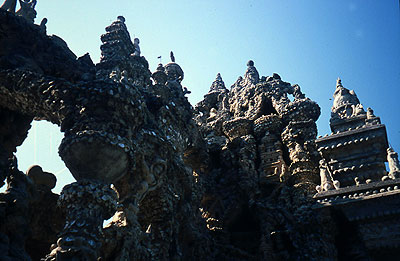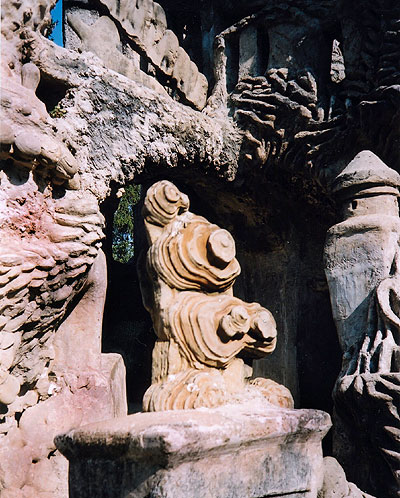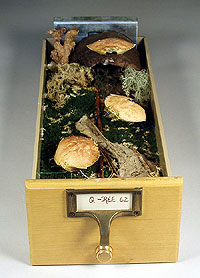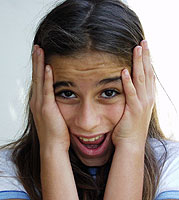
This entry was inspired by the Athanasius Kircher Society's "Visionary Architecture Week" and its
coverage of the "Palais Ideal" in southeastern France. The palace was built by Ferdinand Cheval (1836-1924) over a period of some 33 years and it has been number one on my must-see list for many years. He built it using stones gathered on his rounds as a postman, as well as creating his own forms. I finally made a pilgrimage here in the fall of 2002. It is a wonder to behold. It contains a melange of architectural styles (real and imagined) with columns, arches, turrets, passageways, terraces, and giant statues. Inside and out are grottoes, galleries, rock gardens, and all manner of organic plant and animal creations emerging from it.
The Surrealists were fond of it, especially Andre Breton, who proclaimed Cheval as one of his own. Cheval has an entry in the
Concise Encyclopedia of Surrealism
which says, "The fantastic style of the palace...was often referred to by the Surrealists as an example of dream-life entering the real world."
A number of quotes from him were published in issue 38 of
Raw Vision
as an
autobiography of sorts. He says:
I used to build a fairy-like palace [in my] imagination with all that the genius of a humble man could conceive (with grottoes, towers, gardens, castles, museums and sculptures) ...It so happened that just when my dream was gradually sinking in the mists of oblivion suddenly an incident brought it all back to me: I stumbled on a stone that nearly made me fall. I wanted to examine it closely, my stumbling block: its shape was so bizarre that I picked it up and took it away with me. The following day I went back to the same place and I found more beautiful stones which, gathered on the spot, looked so pretty and filled me with enthusiasm. Then I said to myself: ‘Since Nature provided me with sculptures I shall become an architect and a mason (besides who isn’t a bit of a mason?).'

Among the many details of the palace, one aspect that was of particular interest to me was his display of interesting stones. The inspiring "stumbling block" he mentions can be seen here, perched on a pedestal on an upper terrace, just as any
viewing stone might be. A
particularly intricate and organic rock has been framed in its own
grotto like a religious icon. Some of the rocks which he found contained fossils and other pictorial elements. They are on display together in another nook as the "Museum of Antediluvian Stones".
A comprehensive and well-illustrated documentation of the palace is
Le palais idéal du facteur Cheval: Quand le songe devient la réalité (Collection "Les Bâtisseurs inspirés")
(text in French). This book may also be found at
amazon.fr.
Photographs shown here by Jim Stewart, copyright 2002
For more photos, see
hereFor visiting information, see the
official site
 Last summer I was invited to participate in a project called The Curiosity Cabinet of the Collective Unconscious. The "cabinet" in question was an old library card catalog. Each participant got a drawer in which to create something having to do with the "collective unconscious". In mine, I ended up making a diorama featuring a little family of 3 crab carapaces in a wooded setting (shown here - click for larger view). I mostly work by just putting things together, often precariously, carrying them out to the museum, and possibly having to repair them when Open Studios rolls around. This was the first time that I had made something that needed to be shipped somewhere. The crabs had wires for legs, so they could be secured fairly easily, and the rest was glued or wired down. It was worth it to me to be part of a collaborative project, which was a welcome change for me.
Last summer I was invited to participate in a project called The Curiosity Cabinet of the Collective Unconscious. The "cabinet" in question was an old library card catalog. Each participant got a drawer in which to create something having to do with the "collective unconscious". In mine, I ended up making a diorama featuring a little family of 3 crab carapaces in a wooded setting (shown here - click for larger view). I mostly work by just putting things together, often precariously, carrying them out to the museum, and possibly having to repair them when Open Studios rolls around. This was the first time that I had made something that needed to be shipped somewhere. The crabs had wires for legs, so they could be secured fairly easily, and the rest was glued or wired down. It was worth it to me to be part of a collaborative project, which was a welcome change for me.  In a misguided attempt to "sex up" the
In a misguided attempt to "sex up" the 
